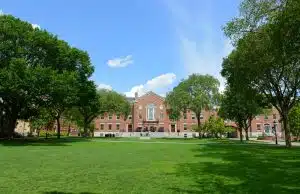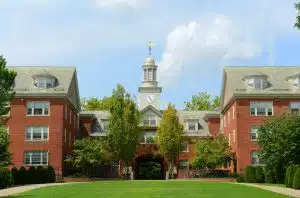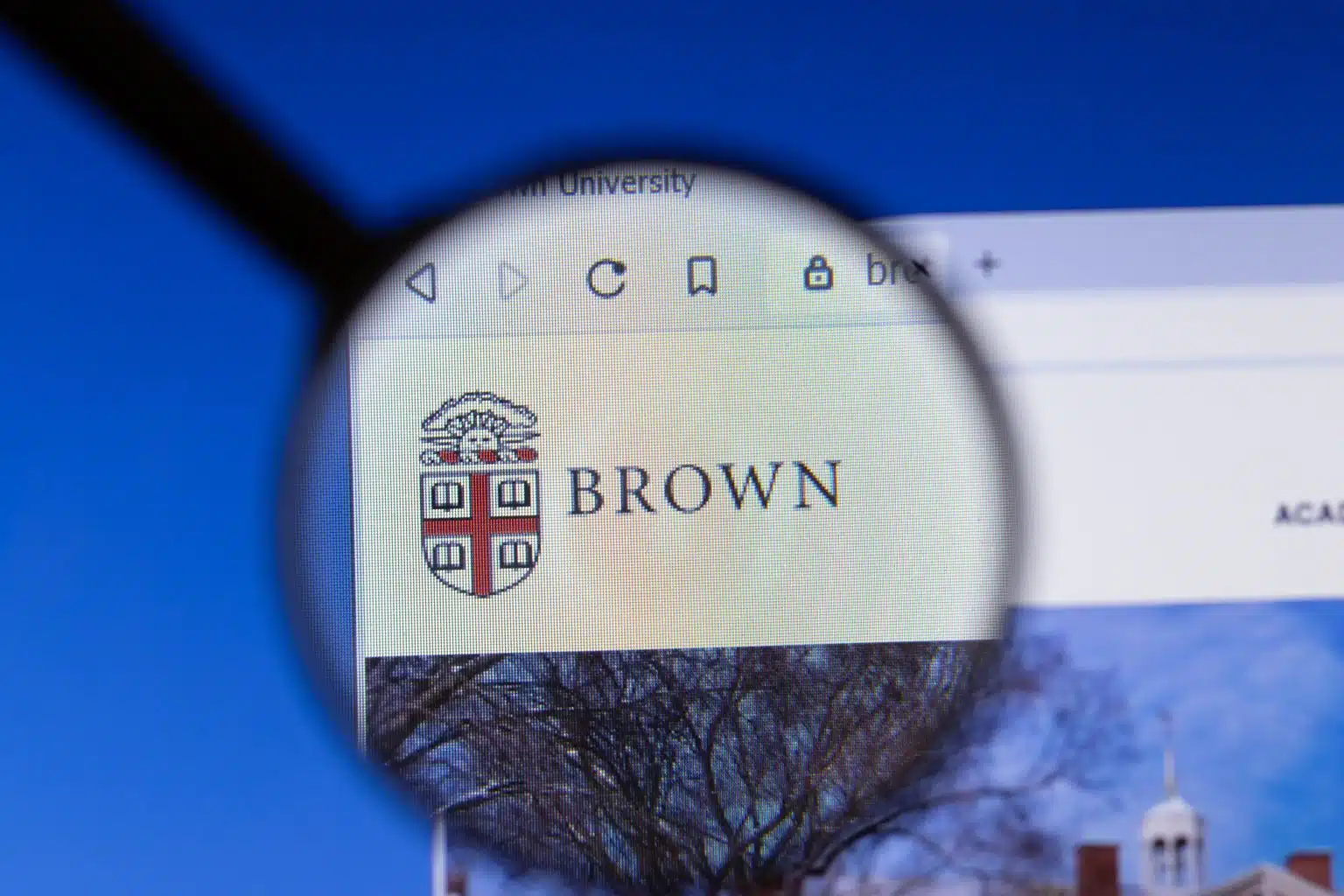Brown University’s Rich Traditions
Rich in tradition and steeped in cultural heritage, Brown University offers a unique blend of academic rigor and vibrant campus life that shapes its identity. From its historic foundation to the iconic campus landmarks, let’s explore what makes Brown University stand out among Ivy League institutions.
Unveiling the History of Brown University
The story of Brown University starts in 1764, making it the seventh-oldest college in the United States. Initially known as the College in the English Colony of Rhode Island and Providence Plantations, the institution was later named Brown University in 1804 in recognition of a generous donation from Nicholas Brown.
Brown University’s history is deeply intertwined with the rich tapestry of American academia and the nation’s journey toward intellectual enlightenment. From its humble beginnings, the university has grown into a renowned institution that continues to shape the minds of generations.

The Founding Years and Early Traditions
The early traditions of Brown University hinged on its mission of fostering a community that values freedom, diversity, and intellectual curiosity. Interestingly, the university was the first in the US to accept students regardless of their religious affiliation, fostering an inclusive scholarly community from its inception.
The founders of Brown University envisioned an educational institution that would not only provide academic excellence but also nurture a sense of social responsibility among its students. This commitment to social justice and equality has been a guiding principle throughout the university’s history.
Even the University Hall, Brown’s oldest building built in 1770, housed soldiers during the American Revolutionary War before being converted back to academic use, showcasing the institution’s rich association with early American history. The echoes of the past can still be felt within the walls of this historic structure, reminding students and faculty of the enduring legacy of Brown University.
Evolution of Traditions Through the Centuries
As centuries went by, Brown continued to uphold its founding principles and embraced progression. The institution was ahead of its time in accepting women through its affiliated female college, Pembroke College, in 1891, much before other Ivy League universities. A move that paved the way toward creating a more equitable academic community.
The inclusion of women at Brown University marked a significant milestone in the university’s history, as it opened doors to a diverse range of perspectives and experiences. This progressive step propelled the institution towards greater heights of academic excellence and innovation.
Throughout its over 250-year history, Brown has maintained a spirit of innovation, shaping traditions that continue to evolve involving a broad spectrum of subjects, from academic pursuits to idiosyncratic student life. The vibrant campus culture at Brown is a testament to the university’s commitment to fostering a dynamic and engaging environment for its students.
From groundbreaking research in various fields to the vibrant arts scene, Brown University has become a hub of intellectual exploration and creativity. Students and faculty alike are encouraged to think critically, challenge conventional wisdom, and push the boundaries of knowledge.
Today, Brown University stands as a testament to the power of education and the enduring legacy of those who dared to dream of a better future. As the institution continues to evolve and adapt to the changing times, it remains committed to its founding principles while embracing the limitless possibilities of the future.

Unique Academic Traditions at Brown University
Brown University’s academic traditions stand testament to its commitment to student autonomy and progressive thinking.
Founded in 1764, Brown University has a rich history of academic excellence and innovation. Over the years, it has developed unique traditions that have shaped the educational experience for generations of students.
The Open Curriculum Philosophy
Brown distinguishes itself with its unique Open Curriculum, adopted in 1969. This philosophy encourages students to take ownership of their academic journey with no general education requirements. Instead, students at Brown personalize their courses, driven by their intellectual curiosity and aspirations, setting a powerful tradition in the academic world.
The Open Curriculum at Brown is more than just a departure from traditional educational models; it is a reflection of the university’s belief in the power of individuality and self-discovery. By allowing students to design their own academic path, Brown empowers them to explore their passions and interests fully.
Through the Open Curriculum, students at Brown have the freedom to pursue a wide range of subjects, from the humanities to the sciences, without being confined by rigid course requirements. This flexibility fosters a spirit of intellectual exploration and encourages students to think critically and creatively across disciplines.
The Open Curriculum leads to exceptional interdisciplinary studies and collaborations, shaping innovative ideas and solutions. The environment at Brown nurtures individuality and creativity, prompting students to reach beyond traditional academic boundaries.
The Tradition of the Shopping Period
Another distinctive academic tradition at Brown is the “Shopping Period” at the beginning of each semester. Students have the freedom to attend any classes for a two-week period before finalizing their course schedule.
This practice allows students to discover their interests and make informed decisions, thus reinforcing Brown’s commitment to fostering a culture that celebrates intellectual exploration.
During the Shopping Period, students can explore a wide range of subjects and attend different lectures and seminars. This unique tradition gives students the opportunity to sample various courses, meet professors, and engage with different academic disciplines before committing to a specific set of classes.
The Shopping Period not only encourages students to explore their academic interests but also promotes a sense of community and collaboration. Students often attend classes together, discussing their impressions and sharing insights. This tradition creates a vibrant and dynamic learning environment where students can learn from each other’s experiences and perspectives.
By embracing the Shopping Period, Brown University demonstrates its commitment to providing students with the tools and resources they need to make informed decisions about their education. This tradition reflects the university’s belief in the importance of student agency and the value of intellectual exploration.
Student Life and Traditions
On the vibrant campus of Brown University, the traditions extend from the classroom to the broader collegiate community. Students at Brown not only engage in rigorous academic pursuits but also actively participate in various traditions that foster a sense of unity, camaraderie, and leisure.
The Joys of Spring Weekend
One of the most anticipated events is the Spring Weekend, a decades-old tradition featuring a lineup of popular musicians and artists. This lively event is a testament to the University’s commitment to blending academia with entertainment and creating an atmosphere of celebration.
During Spring Weekend, the campus comes alive with an infectious energy as students, faculty, and alumni gather to enjoy the performances and revel in the festivities. The air is filled with the sounds of laughter, music, and the clinking of glasses as everyone comes together to celebrate the end of the academic year.
Not only does Spring Weekend provide a much-needed break from the demands of coursework, but it also serves as a platform for students to showcase their talents. Many student organizations and clubs organize performances, art exhibits, and interactive activities, adding to the vibrant atmosphere of the event.
As the sun sets and the music fills the air, friendships are forged, memories are made, and the spirit of unity and leisure thrives. Spring Weekend has become an integral part of the Brown experience, creating lasting bonds and cherished moments that students carry with them long after graduation.
The Midnight Organ Concerts
Another unique tradition at Brown is the midnight organ concerts held at Sayles Hall. Nestled within the heart of the campus, Sayles Hall provides the perfect setting for these enchanting performances.
The grand organ, one of the largest remaining Hutchings-Votey pipe organs, fills the hall with sublime music, creating an atmosphere that is both serene and exhilarating. The deep, resonant tones of the organ reverberate through the space, captivating the audience and transporting them to a world of musical enchantment.
The midnight organ concerts have been a cherished tradition at Brown since the early 1900s. Students and faculty eagerly gather at the stroke of midnight to witness this extraordinary musical experience. The concerts not only offer a unique recreational avenue within the Brown community but also serve as a reminder of the rich history and cultural significance of Sayles Hall.
As the audience sits in awe, surrounded by the grandeur of the hall and immersed in the melodies, a sense of tranquility washes over them. The midnight organ concerts provide a moment of respite from the demands of academic life, allowing students to find solace in the power of music and the beauty of their surroundings.
Attending these concerts has become a cherished tradition for many at Brown, a way to unwind, reflect, and appreciate the finer things in life. The midnight organ concerts symbolize the harmony between tradition, art, and the pursuit of knowledge that defines the Brown experience.

Brown University’s Commencement Traditions
At Brown, commencement traditions are designed to commemorate the academic journey of its students in a grand fashion.
As one of the oldest universities in the United States, Brown University has a rich history of celebrating the accomplishments of its graduating seniors. The commencement traditions at Brown are not only steeped in symbolism but also serve as a reminder of the transformative power of education.
The Historic Walk to the Van Wickle Gates
One of the most cherished moments for any Brown student is walking through the Van Wickle Gates, which only opens twice a year: once to let in the freshmen and once to let out the graduating seniors.
As the graduating seniors approach the Van Wickle Gates, a sense of anticipation fills the air. The gates, adorned with intricate ironwork, stand tall and proud, symbolizing the threshold between the world of academia and the wider world beyond.
This symbolic walk signifies the transition from being a part of the Brown family to stepping into the world as an accomplished Brown graduate. It is a moment of reflection as students look back on their years of hard work, growth, and discovery.
The Van Wickle Gates also holds a special place in the hearts of Brown alumni. Many return to campus on commencement day to witness the new generation of graduates pass through the gates, carrying on the tradition and celebrating the next chapter in their lives.
The Symbolism of the University Mace
The University Mace is a key part of Brown’s commencement parade. Originally designed as a weapon, the mace has evolved into a symbol of authority and respect in academic ceremonies.
As the procession begins, the University Mace, carried by a faculty member, leads the way. Its ornate design and intricate engravings tell a story of the university’s history and values. The mace, with its weight and presence, commands attention and reverence from all who witness it.
Carrying a thousand years of tradition from medieval universities, the mace reminds students and faculty of their integral part in the continuous pursuit of knowledge. It serves as a reminder that education is not just a means to an end but a lifelong journey of intellectual growth and discovery.
As the mace makes its way through the commencement procession, it symbolizes the power and prestige of academic achievement. It is a visual representation of the collective wisdom and accomplishments of the Brown community.
For graduating seniors, seeing the University Mace is a poignant reminder of the transformative power of education and the responsibility they now carry as Brown alumni. It serves as a reminder to use their knowledge and skills to make a positive impact on the world.
As the commencement traditions at Brown University continue to evolve, they remain a testament to the university’s commitment to excellence, intellectual curiosity, and the celebration of academic achievement. Each year, as new graduates embark on their post-graduation journeys, they carry with them the memories and traditions that will forever bind them to their alma mater.
Traditions Around Campus Buildings and Landmarks
Historic buildings and landmarks on the campus of Brown University play pivotal roles in making the Brown experience unique.
The Legend of Carrie Tower
Among the various architectural marvels on the Brown campus, the Carrie Tower stands in special reverence. The tower was built in 1904 as a monument of love from a former student, Paul Bajnotti, to his late wife, Caroline Mathilde Brown.
Today, it serves as a symbol of enduring love and remembrance, resonating with the timeless affection and emotions of the Brown community.
The Whispering Arch of Soldiers Memorial Gate
Another prominent structure on campus, the Soldiers Memorial Gate, holds a unique position in Brown traditions. Built in tribute to the Brown University graduates who lost their lives in World War I, the memorial archway has a distinctive acoustic phenomenon known as the Whispering Arch.
As per tradition, when one person whispers into one side of the arch, another person standing on the opposite side can hear it clearly. This characteristic serves as a metaphor for Brown University’s commitment to ensuring the voice of every member is heard, echoing the institution’s commitment to fostering an engaged community.
From its founding days to the modern era, Brown University’s rich traditions contributed to the formation of a distinctive identity, fostering a unique balance between academic endeavors and a vibrant culture. These traditions not only link students to the university’s storied past but also connect them in envisioning a progressive future, making the Brown journey truly remarkable.
How AdmissionSight Can Help You With College Admissions
AdmissionSight is a college consulting firm that provides personalized assistance to students throughout the college admissions process. Here are some ways that AdmissionSight can help you:
Admissions strategy: AdmissionSight can help you develop a strategic plan for your college application process. Our professional consultants can assist with identifying schools that are a good fit for your academic, extracurricular, and personal goals and help you plan and prioritize your application strategy.
Application review: AdmissionSight can review your application and provide feedback on how to improve it. We can offer suggestions on making your application stand out and highlighting your strengths and unique qualities.
Essay coaching: AdmissionSight can help you craft compelling essays that showcase your personality, goals, and achievements. We can guide you through the essay writing process and provide feedback on your drafts to help you refine your writing.
Interview preparation: AdmissionSight can provide interview coaching to help you feel confident and prepared for college interviews. Our experts can offer tips on how to present yourself professionally and how to answer common interview questions.
Extracurricular planning: AdmissionSight can help you plan and develop your extracurricular activities to make them more impactful and meaningful. We can suggest activities that align with your interests and goals and provide guidance on demonstrating your leadership and initiative.
Overall, AdmissionSight can provide valuable guidance and support throughout the college admissions process to help you maximize your chances of getting accepted into the college of your choice.
With a high success rate of over 75%, we have built a strong network in the past decade. Book an initial consultation today, free of charge!





































